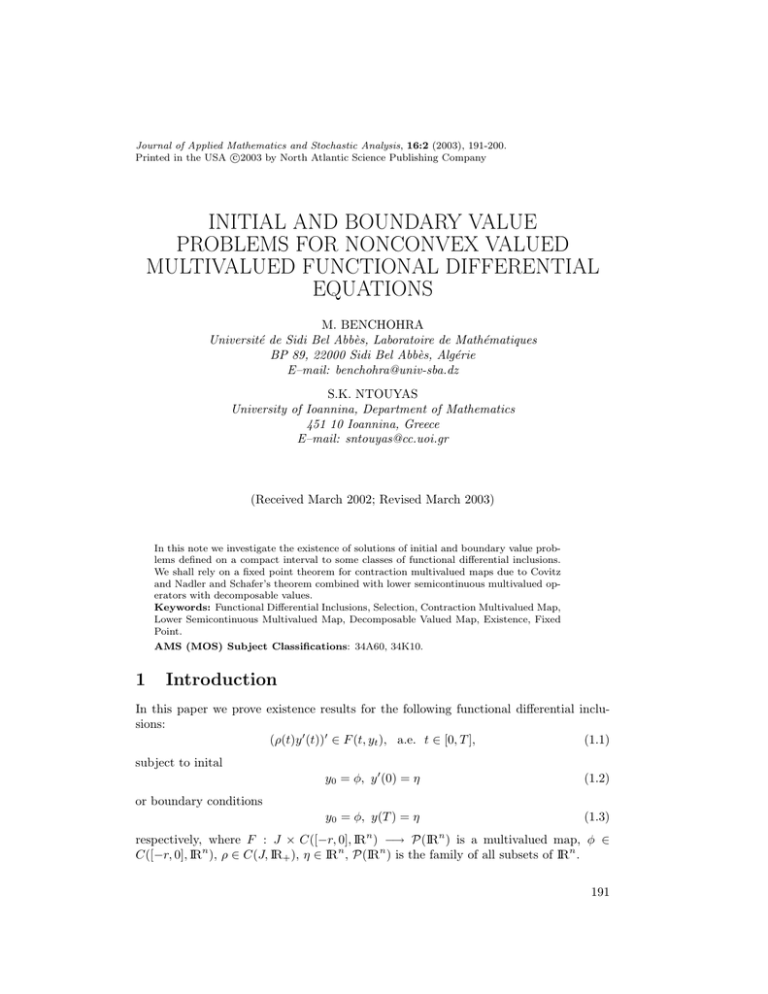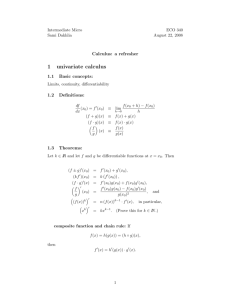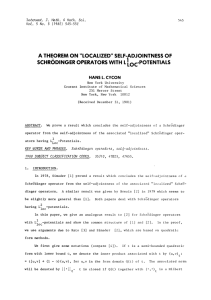Document 10909294
advertisement

Journal of Applied Mathematics and Stochastic Analysis, 16:2 (2003), 191-200.
c
Printed in the USA 2003
by North Atlantic Science Publishing Company
INITIAL AND BOUNDARY VALUE
PROBLEMS FOR NONCONVEX VALUED
MULTIVALUED FUNCTIONAL DIFFERENTIAL
EQUATIONS
M. BENCHOHRA
Université de Sidi Bel Abbès, Laboratoire de Mathématiques
BP 89, 22000 Sidi Bel Abbès, Algérie
E–mail: benchohra@univ-sba.dz
S.K. NTOUYAS
University of Ioannina, Department of Mathematics
451 10 Ioannina, Greece
E–mail: sntouyas@cc.uoi.gr
(Received March 2002; Revised March 2003)
In this note we investigate the existence of solutions of initial and boundary value problems defined on a compact interval to some classes of functional differential inclusions.
We shall rely on a fixed point theorem for contraction multivalued maps due to Covitz
and Nadler and Schafer’s theorem combined with lower semicontinuous multivalued operators with decomposable values.
Keywords: Functional Differential Inclusions, Selection, Contraction Multivalued Map,
Lower Semicontinuous Multivalued Map, Decomposable Valued Map, Existence, Fixed
Point.
AMS (MOS) Subject Classifications: 34A60, 34K10.
1
Introduction
In this paper we prove existence results for the following functional differential inclusions:
(ρ(t)y 0 (t))0 ∈ F (t, yt ), a.e. t ∈ [0, T ],
(1.1)
subject to inital
y0 = φ, y 0 (0) = η
(1.2)
y0 = φ, y(T ) = η
(1.3)
or boundary conditions
respectively, where F : J × C([−r, 0], IRn ) −→ P(IRn ) is a multivalued map, φ ∈
C([−r, 0], IRn ), ρ ∈ C(J, IR+ ), η ∈ IRn , P(IRn ) is the family of all subsets of IRn .
191
192
M. BENCHOHRA and S.K. NTOUYAS.
For any continuous function y defined on the interval [−r, T ] and any t ∈ [0, T ], we
denote by yt the element of C([−r, 0], IRn ) defined by
yt (θ) = y(t + θ), θ ∈ [−r, 0].
Here yt (·) represents the history of the state from time t − r, up to the present time t.
Recently, in [1], the authors studied first and second order initial value problems
for equation (1.1), in the case where ρ(t) = 1, by using a fixed point theorem for
contraction multivalued maps due to Covitz and Nadler [5] (see also Deimling [6]). Using
a fixed point theorem for condensing multivalued maps due to Martelli, the authors
have obtained an existence result for the initial value problem (1.1)-(1.2). Here, by
using the fixed point theorem for contraction maps and Schaefer’s theorem combined
with a selestion theorem of Bressan and Colombo for lower semicontinuous multivalued
operators with decomposable values, existence results are proposed for problems (1.1)(1.2) and (1.1)-(1.3).
2
Preliminaries
In this section, we introduce notations, definitions, and preliminary facts from multivalued analysis which are used throughout this note.
C([−r, 0], IRn ) is the Banach space of all continuous functions from [−r, 0] into IRn
with the norm
kφk = sup{|φ(θ)| : −r ≤ θ ≤ 0}.
By C([0, T ], IRn ), we denote the Banach space of all continuous functions from [0, T ]
into IRn with the norm
kyk[0,T ] := sup{|y(t)| : t ∈ [0, T ]}.
L1 ([0, T ], IRn ) denotes the Banach space of measurable functions y : [0, T ] −→ IRn
which are Lebesgue integrable normed by
Z T
|y(t)|dt for all y ∈ L1 ([0, T ], IRn ).
kykL1 =
0
AC i ([0, T ], IRn ) is the space of i-times differentiable functions y : [0, T ] → IRn , whose
ith derivative, y (i) , is absolutely continuous.
Let A be a subset of [0, T ] × IRn . A is L ⊗ B measurable if A belongs to the σ-algebra
generated by all sets of the form N × D where N is Lebesgue measurable in J and D
is Borel measurable in IRn . A subset B of L1 ([0, T ], IRn ) is decomposable if, for all
u, v ∈ B and N ⊂ [0, T ] measurable, the function uχN + vχJ−N ∈ B, where χ denotes
for the characteristic function.
Let E be a Banach space, X a nonempty closed subset of E and G : X → P(E) a
multivalued operator with nonempty closed values. G is lower semi-continuous (l.s.c.)
if the set {x ∈ X : G(x) ∩ C 6= ∅} is open for any open set C in E. G has a fixed point
if there is x ∈ X such that x ∈ G(x).
Definition 2.1: Let Y be a separable metric space and let N : Y → P(L1 ([0, T ], IRn ))
be a multivalued operator. We say N has property (BC) if
1) N is lower semi-continuous (l.s.c.);
Functional Differential Inclusions
193
2) N has nonempty closed and decomposable values.
Let F : [0, T ] × C([−r, 0], IRn ) → P(IRn ) be a multivalued map with nonempty
compact values. Assign to F the multivalued operator
F : C([−r, T ], IRn ) → P(L1 ([0, T ], IRn ))
by letting
F(y) = {w ∈ L1 ([0, T ], IRn ) : w(t) ∈ F (t, yt ) for a.e. t ∈ [0, T ]}.
The operator F is called the Niemytzki operator associated with F. We say F is of
lower semi-continuous type (l.s.c. type) if its associated Niemytzki operator F is lower
semi-continuous and has nonempty closed and decomposable values.
Next we state a selection theorem due to Bressan and Colombo.
Lemma 2.1: [3] Let Y be separable metric space and let N : Y → P(L1 ([0, T ], IRn ))
be a multivalued operator which has property (BC). Then N has a continuous selection,
i.e. there exists a continuous function (single-valued) g : Y → L1 ([0, T ], IRn ) such that
g(y) ∈ F (y) for every y ∈ Y.
Let (X, d) be a metric space. We use the notations:
P (X) = {Y ∈ P(X) : Y 6= ∅}, Pcl (X) = {Y ∈ P (X) : Y closed}, Pb (X) =
{Y ∈ P (X) : Y bounded}.
Consider Hd : P (X) × P (X) −→ IR+ ∪ {∞}, given by
Hd (A, B) = max sup d(a, B), sup d(A, b) ,
a∈A
b∈B
where d(A, b) = inf d(a, b), d(a, B) = inf d(a, b).
a∈A
b∈B
Then (Pb,cl (X), Hd ) is a metric space and (Pcl (X), Hd ) is a generalized metric space.
Definition 2.2: A multivalued operator N : X → Pcl (X) is called
a) γ-Lipschitz if and only if there exists γ > 0 such that
Hd (N (x), N (y)) ≤ γd(x, y),
for each x, y ∈ X,
b) contraction if and only if it is γ-Lipschitz with γ < 1.
For more details on multivalued maps and the proof of known results cited in this
section we refer to the books of Deimling [6], Górniewicz [8], Hu and Papageorgiou [9]
and Tolstonogov [11].
Our considerations are based on the following fixed point theorem for contraction
multivalued operators given by Covitz and Nadler in 1970 [5] (see also Deimling, [6]
Theorem 11.1).
Lemma 2.2: Let (X, d) be a complete metric space. If N : X → Pcl (X) is a
contraction, then F ixN 6= ∅.
3
Initial Value Problems
Now, we are able to state and prove our main theorems. In this section we shall give
two results for the IVP (1.1)–(1.2). Before stating and proving these results, we give
the definition of a solution of the IVP (1.1)–(1.2).
194
M. BENCHOHRA and S.K. NTOUYAS.
Definition 3.1: A function y : [−r, T ] −→ E is called solution for the IVP (1.1)(1.2) if y(·), ρ(·)y(·) ∈ C([−r, T ], IRn ) ∩ AC 1 ([0, T ], IRn ) and satisfies the differential
inclusion (1.1) a.e. on [0, T ] and the conditions (1.2).
Theorem 3.1: Assume that:
(H1) F : [0, T ] × C([−r, 0], IRn ) −→ Pcl (IRn ) has the property that F (·, u) : [0, T ] →
Pcl (IRn ) is measurable for each u ∈ C([−r, 0], IRn );
(H2) Hd (F (t, u), F (t, u)) ≤ l(t)ku − uk, for each t ∈ [0, T ] and u, u ∈ C([−r, 0], IRn ),
where l ∈ L1 ([0, T ], IR), and d(0, F (t, 0)) ≤ l(t) for a.e. t ∈ [0, T ].
Z T
Then the IVP (1.1)-(1.2) has at least one solution on [−r, T ] provided T ρ−1
l(s)ds <
0
0
1, where ρ0 = min{ρ(t) : t ∈ [0, T ]}.
Proof: Transform the problem into a fixed point problem. Consider the multivalued
operator N : C([−r, T ], IRn ) → P(C([−r, T ], IRn )) defined by:
N (y) =
h ∈ C([−r, T ], IR
n
φ(t),
φ(0) + ρ(0)η Z
) : h(t) =
Z
Z
1
t
+
0
if t ∈ [−r, 0]
t
0
ds
ρ(s)
s
ρ(s)
g(τ )dτ ds,
if t ∈ [0, T ], g ∈ SF (y)
0
where
n
o
SF (y) = g ∈ L1 ([0, T ], IRn ) : g(t) ∈ F (t, yt ) for a.e. t ∈ [0, T ] .
Remark 3.1:
(i) It is clear that the fixed points of N are solutions to (1.1)-(1.2).
(ii) for each y ∈ C([−r, T ], IRn ) the set SF (y) is nonempty since by (H1) F has a
measurable selection (see [4], Theorem III.6).
We shall show that N satisfies the assumptions of Lemma 2.2. The proof will be
given in two steps.
Step 1: N (y) ∈ Pcl (C(−r, T ], IRn ) for each y ∈ C([−r, T ], IRn ).
Indeed, let (yn )n≥0 ∈ N (y) such that yn −→ ỹ in C[−r, T ], IRn ). Then ỹ ∈
C[−r, T ], IRn ) and
Z t
Z s
Z t
ds
1
yn (t) ∈ φ(0) + ρ(0)η
+
F (τ, yτ )dτ ds, t ∈ [0, T ].
0 ρ(s)
0 ρ(s) 0
Using the fact that F has closed values and from the second part of (H2), we can
Z t
easily show that
F (s, ys )ds is closed for each t ∈ [0, T ]. Then
0
yn (t) −→ φ(0) + ρ(0)η
Z
t
0
So ỹ ∈ N (y).
ds
+
ρ(s)
Z
t
0
1
ρ(s)
Z
s
F (τ, yτ )dτ ds, t ∈ [0, T ].
0
Functional Differential Inclusions
195
Step 2: Hd (N (y1 ), N (y2 )) ≤ γky1 −y2 k[−r,T ] for each y1 , y2 ∈ C[−r, T ], IRn ) (where
γ < 1).
Let y1 , y2 ∈ C([−r, T ], IRn ) and h1 ∈ N (y1 ). Then there exists g1 (t) ∈ F (t, y1t ) such
that
Z t
Z s
Z t
ds
1
+
h1 (t) = φ(0) + ρ(0)η
g1 (τ )dτ ds, t ∈ [0, T ].
0 ρ(s)
0 ρ(s) 0
From (H2) it follows that
Hd (F (t, y1t ), F (t, y2t )) ≤ l(t)ky1t − y2t k.
Hence there is w ∈ F (t, y2t ) such that
kg1 (t) − wk ≤ l(t)ky1t − y2t k,
t ∈ [0, T ].
Consider U : [0, T ] → P(IRn ), given by
U (t) = {w ∈ IRn : kg1 (t) − wk ≤ l(t)ky1t − y2t k}.
Since the multivalued operator V (t) = U (t) ∩ F (t, y2t ) is measurable (see Proposition
III.4 in [4]), there exists g2 (t) a measurable selection for V . So, g2 (t) ∈ F (t, y2t ) and
kg1 (t) − g2 (t)k ≤ l(t)ky1t − y2t k, for each t ∈ [0, T ].
Let us define for each t ∈ [0, T ]
h2 (t) = φ(0) + ρ(0)η
Z
t
0
ds
+
ρ(s)
Z
t
0
1
ρ(s)
Z
s
g2 (τ )dτ ds.
0
Then we have
kh1 (t) − h2 (t)k
≤
≤
=
=
=
≤
≤
Z t
T
kg1 (s) − g2 (s)k ds
ρ0 0
Z t
T
l(s)ky1s − y2s kds
ρ0 0
Z t
T
l(s)
sup |y1s (θ) − y2s (θ)| ds
ρ0 0
−r≤θ≤0
Z t
T
l(s)
sup |y1 (s + θ) − y2 (s + θ)| ds
ρ0 0
−r≤θ≤0
Z t
T
l(s)
sup |y1 (z) − y2 (z)| ds
ρ0 0
s−r≤z≤s
Z t
T
l(s)
sup |y1 (z) − y2 (z)| ds
ρ0 0
−r≤z≤T
!
Z T
T
l(s)ds ky1 − y2 k[−r,T ] .
ρ0 0
Then
kh1 − h2 k[−r,T ] ≤
T
ρ0
Z
T
!
l(s)ds ky1 − y2 k[−r,T ] .
0
196
M. BENCHOHRA and S.K. NTOUYAS.
By the analogous relation, obtained by interchanging the roles of y1 and y2 , it follows
that
!
Z T
T
l(s)ds ky1 − y2 k[−r,T ] .
Hd (N (y1 ), N (y2 )) ≤
ρ0 0
So, N is a contraction and thus, by Lemma 2.2, it has a fixed point y, which is solution
to (1.1)-(1.2).
By the help of the Schaefer’s theorem combined with the selection theorem of Bressan
and Colombo for lower semicontinuous maps with decomposable values, we shall present
an existence result for the problem (1.1)-(1.2). Before this, let us introduce the following
hypotheses which are assumed hereafter:
(H3) F : [0, T ] × C([−r, 0], IRn ) −→ P(IRn ) is a nonempty compact valued multivalued
map such that
a) (t, u) 7→ F (t, u) is L ⊗ B measurable;
b) u 7→ F (t, u) is lower semi-continuous for a.e. t ∈ [0, T ];
(H4) For each q > 0, there exists a function hq ∈ L1 ([0, T ], IR+ ) such that
kF (t, u)k :=
sup{|v| : v ∈ F (t, u)} ≤ hq (t)
for a.e. t ∈ [0, T ] and u ∈ C([−r, 0], IRn ) with kuk ≤ q.
In the proof of our following theorem, we will need the auxiliary result:
Lemma 3.1: [7]. Let F : [0, T ] × C([−r, 0], IRn ) → P(IRn ) be a multivalued map
with nonempty, compact values. Assume (H3) and (H4) hold. Then F is of l.s.c. type.
Theorem 3.2: Suppose, in addition to hypotheses (H3), (H4), the following also
holds:
(H5) kF (t, u)k := sup{|v| : v ∈ F (t, u)} ≤ p(t)ψ(kuk) for almost all t ∈ [0, T ] and all
u ∈ C([−r, 0], E), where p ∈ L1 ([0, T ], IR+ ) and ψ : IR+ −→ (0, ∞) is continuous
and increasing with
Z T
Z ∞
T
dτ
,
p(s)ds <
ρ0 0
ψ(τ
)
c
where c = kφk + ρ(0)|η|
T
.
ρ0
Then the initial value problem (1.1)–(1.2) has at least one solution.
Proof: (H3) and (H4) imply by Lemma 3.1 that F is of lower semi-continuous
type. Then, from Lemma 2.1, there exists a continuous function f : C([0, T ], IRn ) →
L1 ([0, T ], IRn ) such that f (y) ∈ F(y) for all y ∈ C([0, T ], IRn ).
We consider the problem
(ρ(t)y 0 (t))0 = f (y)(t), a.e. t ∈ J = [0, T ],
(3.1)
y0 = φ, y 0 (0) = η.
(3.2)
Remark 3.2: If y ∈ C([−r, T ], IRn ) is a solution of the problem (3.1)–(3.2), then y
is a solution to the problem (1.1)-(1.2).
Functional Differential Inclusions
197
Transform problem (3.1) - (3.2) into a fixed point problem. Consider the multivalued
map, N : C([−r, T ], IRn ) −→ C([−r, T ], IRn ) defined by:
φ(t),
if t ∈ [−r, 0]
Z
Z
Z
t
t
s
N (y)(t) =
ds
1
φ(0) + ρ(0)η
+
f (y)(u)duds, if t ∈ [0, T ].
0 ρ(s)
0 ρ(s) 0
Clearly from (H4) and the Arzela-Ascoli theorem, the multivalued operator N is continuous and completely continuous.
In order to apply Schaefer’s theorem, it remains to show that the set
E(N ) := {y ∈ C([−r, T ], IRn ) : λy = N (y), for some λ > 1}
is bounded. Let y ∈ E(N ). Then λy = N (y) for some λ > 1. Thus, for each t ∈ [0, T ]
Z t
Z s
Z t
ds
1
+ λ−1
y(t) = λ−1 φ(0) + λ−1 ρ(0)η
f (y)(τ )dτ ds.
0 ρ(s)
0 ρ(s) 0
This implies by (H5) that for each t ∈ [0, T ] we have
Z t
T
T
p(s)ψ(kys k)ds.
|y(t)| ≤ kφk + ρ(0)|η| +
ρ0
ρ0 0
We consider the function µ defined by
µ(t) = sup{|y(s)| : −r ≤ s ≤ t}, 0 ≤ t ≤ T.
Let t∗ ∈ [−r, t] be such that µ(t) = |y(t∗ )|. If t∗ ∈ [0, T ], by the previous inequality we
have for t ∈ [0, T ]
Z t
T
T
µ(t) ≤ kφk + ρ(0)|η| +
p(s)ψ(µ(s))ds.
ρ0
ρ0 0
If t∗ ∈ [−r, 0], then µ(t) = kφk and the previous inequality holds.
Let us take the right-hand side of the above inequality as v(t); then we have
c = v(0) = kφk + ρ(0)|η|
and
v 0 (t) =
T
,
ρ0
µ(t) ≤ v(t), t ∈ [0, T ]
T
p(t)ψ(µ(t)), t ∈ [0, T ].
ρ0
Using the nondecreasing character of ψ, we get
v 0 (t) ≤
T
p(t)ψ(v(t)), t ∈ [0, T ].
ρ0
This implies for each t ∈ [0, T ] that
Z
v(t)
v(0)
T
du
≤
ψ(u)
ρ0
Z
T
p(s)ds <
0
Z
∞
v(0)
du
.
ψ(u)
198
M. BENCHOHRA and S.K. NTOUYAS.
This inequality implies that there exists a constant b = b(T, p, ψ) such that v(t) ≤ b, t ∈
[0, T ], and hence µ(t) ≤ b, t ∈ [0, T ]. Since for every t ∈ [0, T ], kyt k ≤ µ(t), we have
kyk[r,T ] := sup{|y(t)| : −r ≤ t ≤ T } ≤ max(b, kφk).
This shows that E(N ) is bounded. As a consequence of Schaefer’s theorem (see [10]),
we deduce that N has a fixed point which is a solution of (3.1)-(3.2) and hence from
Remark 3.2, a solution to the problem (1.1)-(1.2) .
4
Boundary Value Problems
In the next theorem we give an existence result for the BVP (1.1), (1.3).
Definition 4.1: A function y : [−r, T ] −→ IRn is called solution for the BVP (1.1),
(1.3) if y(·), ρ(·)y(·) ∈ C([−r, T ], IRn ) ∩ AC 1 ([0, T ], IRn ) and satisfies the differential
inclusion (1.1) a.e. on [0, T ] and the boundary condition (1.3).
Theorem 4.1: Let F satisfies (H1) and (H2). Then the BVP (1.1), (1.3) has at
least one solution on [−r, T ].
Proof: As in Theorem 3.1 we transform the problem into a fixed point problem.
Consider the multivalued operator N1 : C([−r, T ], IRn ) → P(C([−r, T ], IRn )) defined
by:
N1 (y) :=
h ∈ C([−r, T ], IR
n
Z
φ(t),
η − φ(0)
+
ω(t)
) : h(t) =
ω(T )
φ(0)
Z
+ G(t, s)g(s)ds,
if t ∈ [−r, 0]
T
if t ∈ [0, T ], g ∈ SF (y)
0
t
1
ds and G is the Green’s function for the corresponding homogenρ(s)
0
uous problem which is given by the formula
ω(t)
−
1
, if 0 ≤ s ≤ t ≤ T
ω(s)
ω(T )
G(t, s) =
ω(s)
ω(t)
− 1 , if 0 ≤ t ≤ s ≤ T.
ω(T )
where ω(t) =
We shall show that N1 satisfies the assumptions of Lemma 2.1.
Using the same reasoning as in Step 1 of Theorem 3.1, we can show that N1 (y) ∈
Pcl (C(−r, T ], IRn ), for each y ∈ C([−r, T ], IRn ).
N1 is a contraction multivalued map. Indeed, let y1 , y2 ∈ C[−r, T ], IRn ) and h1 ∈
N1 (y1 ). Then there exists g1 (t) ∈ F (t, y1t ) such that
Z T
η − φ(0)
ω(t) +
G(t, s)g1 (s)ds, t ∈ [0, T ].
h1 (t) = φ(0) +
ω(T )
0
From (H2) it follows that
Hd (F (t, y1t ), F (t, y2t )) ≤ l(t)ky1t − y2t k.
Functional Differential Inclusions
199
Hence, there is w ∈ F (t, y2t ) such that
kg1 (t) − wk ≤ l(t)ky1t − y2t k,
t ∈ [0, T ].
Consider U : [0, T ] → P(IRn ), given by
U (t) = {w ∈ IRn : kg1 (t) − wk ≤ l(t)ky1t − y2t k}.
Since the multivalued operator V (t) = U (t) ∩ F (t, y2t ) is measurable (see Proposition
III.4 in [4]), there exists g2 (t) a measurable selection for V . So, g2 (t) ∈ F (t, y2t ) and
kg1 (t) − g2 (t)k ≤ l(t)ky1t − y2t k, for each t ∈ [0, T ].
Let us define for each t ∈ [0, T ]
h2 (t) = φ(0) +
η − φ(0)
ω(t) +
ω(T )
Z
T
G(t, s)g2 (s)ds.
0
Then we have
kh1 (t) − h2 (t)k ≤
Z
T
G(t, s)kg1 (s) − g2 (s)k ds
0
≤
sup
|G(t, s)|
[0,T ]×[0,T ]
≤
Z
T
l(s)ky1s − y2s kds
0
sup
Z
|G(t, s)|
[0,T ]×[0,T ]
Then
kh1 − h2 k[−r,T ] ≤
sup
|G(t, s)|
[0,T ]×[0,T ]
T
!
l(t)dt ky1 − y2 k[−r,T ] .
0
Z
T
!
l(t)dt ky1 − y2 k[−r,T ] .
0
By the analogous relation, obtained by interchanging the roles of y1 and y2 , it follows
that
!
Z T
l(t)dt ky1 − y2 k[−r,T ] .
Hd (N1 (y1 ), N1 (y2 )) ≤ sup |G(t, s)|
J×J
So, if we choose
sup
[0,T ]×[0,T ]
|G(t, s)|
Z
0
T
l(t)dt < 1, N1 is a contraction, and thus, by
0
Lemma 2.2, it has a fixed point y, which is solution to (1.1), (1.3).
Using the reasoning used in the proof of Theorem 3.2, we can obtain the following
result where the details are left to the reader.
Theorem 4.2: Let F satisfy (H3) and
(H6) there exists a function h ∈ L1 ([0, T ], IR+ ) such that
kF (t, u)k := sup{|v| : v ∈ F (t, u)} ≤ h(t) for a.e. t ∈ [0, T ] and u ∈ C([−r, 0], IRn ).
Then the BVP (1.1), (1.3) has at least one solution on [−r, T ].
200
M. BENCHOHRA and S.K. NTOUYAS.
References
[1] Benchohra, M. and Ntouyas, S.K., Existence results for functional differential inclusions,
Electron. J. Differential Equations 41 (2001), 1–8.
[2] Benchohra, M. and Ntouyas, S.K., Existence results for second order functional differential
and integrodifferential inclusions in Banach spaces, Tamkang J. Math. 32:4 (2001), 315–
325.
[3] Bressan, A. and Colombo, G., Extensions and selections of maps with decomposable
values, Studia Math. 90 (1988), 69–86.
[4] Castaing, C. and Valadier, M., Convex Analysis and Measurable Multifunctions, Lecture
Notes in Mathematics 580, Springer-Verlag, New York 1977.
[5] Covitz, H. and Nadler, Jr., S.B., Multivalued contraction mappings in generalized metric
spaces, Israel J. Math. 8 (1970), 5–11.
[6] Deimling, K., Multivalued Differential Equations, Walter de Gruyter, New York 1992.
[7] Frigon, M. and Granas, A., Théorèmes d’existence pour des inclusions différentielles sans
convexité, C. R. Acad. Sci. Paris, Ser. I 310 (1990), 819–822.
[8] Gorniewicz, L., Topological Fixed Point Theory of Multivalued Mappings, Mathematics
and Its Applications 495, Kluwer Academic Publishers, Dordrecht 1999.
[9] Hu, S. and Papageorgiou, N., Handbook of Multivalued Analysis, Volume I: Theory, Kluwer
Academic Publishers, Dordrecht 1997.
[10] Smart, D.R., Fixed Point Theorems, Cambridge Univ. Press, Cambridge 1974.
[11] Tolstonogov, A.A., Differential Inclusions in a Banach Space, Kluwer Academic Publishers, Dordrecht 2000.






